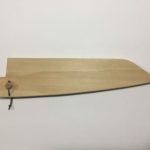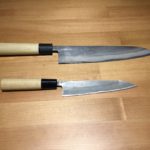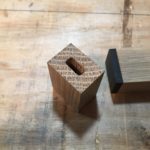
by Colton | Nov 29, 2017 | Kitchen Tools, Knives, Saya
This Poplar saya is for a Shun Kiritsuke 8 inch. I was playing around with thicknesses on this saya to dial in exactly how thick will give good protection but not look too bulky. This is an example of the Poplar sayas I will be offering for sale.
-

-
This is before thinning out the walls with a hand plane.
-

-
Before applying boiled linseed oil finish.
-

-

-

-


by Colton | Nov 26, 2017 | Kitchen Tools, Saya
Saya is the Japanese term for a scabbard or sheath specifically for a sword or knife. While researching the design and construction of these I discovered the main complaint about them was losing the retaining pin that keeps the knife locked inside. So I came up with a way of tethering the pin to the saya. Not a new idea but it functions well and suits the style of construction.
The method of construction is lamination. For this particular saya there is three layers. Poplar on the outsides and cedar on the inside. The retaining pin is made of Arbutus. All using traditional hand tool methods. The only time a machine came into play was for drilling the holes. The finish is Boiled Linseed Oil.

by Colton | Nov 18, 2017 | Kitchen Tools, Knives, Saya
This is the Tojiro 150 mm petty that I purchased along with the 210 mm gyuto. I decided to go with a slightly different handle configuration using the same woods. The saya is constructed of Poplar and painted with black milk paint.
Milk paint is made using milk protein, lime and earth or mineral pigments. It is environmentally friendly and non-toxic. It has been used for hundreds of years on furniture and in the past families typically had their own recipe they would pass down through the generations. It is water based so it doesn’t just form a layer on top of the surface that can chip off. It gets into the pores of the wood more like a stain than modern paints.
Handle Dimensions:
Overall Length: 110 mm
Width: 15 mm
Height: 22 mm
Ferrule: 10 mm
-

-
White Oak and Ebony handle blank.
-

-
Handle blank next to 150 mm blade.
-

-
Handle blank next to 150 mm blade.
-

-
Hand planed to final hexagonal shape and drilled to fit the tang of the blade.
-

-
I always tape off the sharp cutting edge of a knife before doing any handle work.
-

-
Knife saya with a coat of black milk paint.
-

-
Finished knife. Handle has boiled linseed oil finish
-

-
Finished knife. Handle has boiled linseed oil finish
-

-
Finished knife. Handle has boiled linseed oil finish

by Colton | Nov 9, 2017 | Kitchen Tools, Knives
Working in a kitchen, I get to play with knives quite often. I also tend to buy more knives than I will ever need… This Tojiro 21cm Gyuto (Japanese Chef Knife) and 15cm Petty were my latest purchase from the friendly bunch over at Bernal Cutlery down in San Francisco. Originally I planned to treat the blades, oil the handles and put them work. That was the case for a short time… until I was inspired to try making a Saya. Saya is wooden sheath with retaining pin.
In typical fashion for me I decided hey why not make a Saya and rehandle it! I have been wanting to try rehandling a Japanese knife for a while and decided to go for it. I use the 15cm Petty more often at work so I decided to start with the Gyuto. In the next week or two I will give the Petty knife the same treatment.
The woods used are White Oak and Ebony. The Ebony is the keys from a decommissioned piano so I’m not sure what species it is. Everything is finished with boiled linseed oil.
Handle Dimensions:
Length: 135 mm
Width: 18 mm
Height: 26 mm
Ferrule: 36 mm
Ebony: 4.5 mm
-

-
Tojiro Gyuto (21cm) and Petty (15cm)
-

-
The blades after a citric acid bath. This helps kickstart a patina that resists rust.
-

-
White Oak that has been cut down for the handle.
-

-
Three Ebony piano keys planed down and ready for glue-up.
-

-
The resulting Ebony block.
-

-
Mock-up of the White Oak handle with Ebony spacer.
-

-
Ferrule is drilled. I also drilled the remaining piece of the handle. Just seemed easier to do in two pieces.
-

-
Handle assembled.
-

-
I freehanded the chamfered edges to create an octagonal shape.
-

-
Traditionally the tang would be heated red hot and fitted to the handle that way. I don’t have a torch so I opted for epoxy.
-

-
Ripping 7cm thick Oak for the sheath. The handle and sheath are from the same piece of White Oak.
-

-
Piece two of the sheath. I carved out the knife profile before lamiating the two pieces together.
-

-
The laminated sheath and Ebony retaining pin.
-

-
I finished the knife handle and sheath with boiled linseed oil.
-

-
Tojiro White #2 Carbon Steel Gyuto – 21cm. Rehandled with White Oak and Ebony.
-

-
Tojiro White #2 Carbon Steel Gyuto – 21cm. Rehandled with White Oak and Ebony. Saya made with the same woods.
-

-
Tojiro White #2 Carbon Steel Gyuto – 21cm. Rehandled with White Oak and Ebony. Saya made with the same woods.
-

-
Tojiro White #2 Carbon Steel Gyuto – 21cm. Rehandled with White Oak and Ebony. Saya made with the same woods.

by Colton | Sep 7, 2017 | Tools, Woodworking
This plane is made in the Taiwanese style. The body is 25cm long and made from a solid piece of White Oak. The wedge is Soft Maple.
Put to use it glided over the stock surface and easily produced fine shavings. I am quite pleased with how it turned out!
Plane Dimensions:
Length: 25 cm
width: 6.5 cm
Height: 4.5 cm
Toe: 15 cm
Mouth: 0.5 mm
Brass Pin: 3.1 cm from bottom to centre
Blade Width: 4.8 cm
I started by ripping a piece off of my slab of White Oak. I used the outside section to get grain close to quarter sawn. Before planing the stock square on six sides, you need to establish which side is the sole and which end is the toe. For the sole of the plane you want the side that was the closest to the centre of the tree. That will be the tightest grain, making it the most durable side. With the sole facing the ground and looking at the profile (side) of the plane; you want the grain to be running parallel with the sole. If it’s not, the grain needs to be sloping downward from toe to heel. That way it reduces friction, enabling the plane to more easily glide over the surface of what you’re planing.
The mouth of the plane is located 60% of the distance from the toe. This makes the toe of this plane 15 cm and the heel 10 cm. All of the other layout is based off the location of the mouth. First I went with a 45 degree angle bed for the blade. Then added the mark for the thickness of the blade. Off of this I add in wedge angle. Once all of these are marked out I can mark the placement of the wedge pin. This pin is located 66% from the bottom. All that is left to do is mark the top and bottom to coincide with the width of the blade and start chiseling out the waste.
Once you have that all done you can move on to seating the blade in the bed. This takes quite a bit of effort and patience. Using a pencil, scribble on the face of the blade that will be resting on the bed. Insert the blade in the plane and with firm downward pressure, rub it up and down. This will show you were the high spots are. Using a file you slowly remove all these high spots. Repeat this process a few times until you’re getting even contact between the blade and the bed. Taking the time to get a good fit makes the difference between a plane that sings and plane that sits on the shelf because it just chatters and makes a mess.
When fitting the wedge you want to make sure there is even contact and pressure being applied across the whole width of the blade. I haven’t experimented too much with wedge angles but have found that 1:6 works great. Measure 6 cm and 1 cm up, then mark a line from the corner through the top of the 1 cm mark and you have your angle. I have one drawn on my bench hook so I can quickly grab the angle using my sliding T-bevel.
-

-
Slab 7cm thick White Oak ripped and crosscut. Saw for scale.
-

-
This a profile shot of the plane with the marked layout. The toe of the plane is located to the left. The bed angle for the blade is 45 degrees.
-

-
Here we have the wedge pin installed and the blade making proper contact with the bed. Now about the fit the Maple wedge.
-

-
Front 3/4 view.
-

-
Back view.
-

-
Front 3/4 view with a brass plane hammer from Lee Valley.
-

-
Here is a piece of pine I tried my new hand plane on after sharpening.


















































